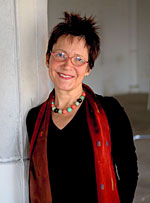 Gwendolyn Wright | |
| Photo: © Amy Etra / PBS |
Correction appended November 2, 2007
If you didn’t know better, you might think that the history of women practicing architecture and design began with women’s lib during the 1960s. Earlier figures including Lilly Reich or Catherine Bauer are virtually unknown despite their central role in high-profile projects: Reich co-designed the famous Barcelona chair, usually attributed solely to Mies van der Rohe, and Bauer was as an early hero of social housing who co-authored the Housing Act of 1937, establishing public housing in the U.S.
Who better to help uncover these forgotten stories than Gwendolyn Wright, a host on the popular PBS series History Detectives and professor of architecture at Columbia University’s Graduate School of Architecture, Planning, and Preservation. She was the keynote speaker last Thursday at a conference titled Women in Modernism: Making Places in Architecture. The event was sponsored by the Museum of Modern Art (MoMA) in Manhattan and the Beverly Willis Architecture Foundation with the goal of re-contextualizing the role that women played in Modernism.
Wright outlined certain myths that have perpetuated incomplete versions of history, offering as an example the idea that many 20th century arbiters overvalued an ideal type of architect who was hyper-rational, uncompromisingly idealistic, and invariably male. As a result, important figures falling outside that standard were either unnoticed or, if they did achieve recognition, soon forgotten. For example, even with today’s booming interest in sustainability it’s a rather obscure fact that architect Eleanor Raymond, who worked in Boston for more than 50 years, and chemist Dr. Maria Telkes, from M.I.T., built what was arguably the first solar-powered house, the Dover Sun House, in 1948. Wright challenged the audience to resist “myths that are clearer and more convenient than real history.”
The most telling example Wright sleuthed out was Katherine Mock, head of MoMA’s Department of Architecture from 1942 to 1946. Mock organized an exhibit in 1944 entitled Built in USA: 1932-1944 that expanded on Philip Johnson’s already canonical 1932 exhibit, Modern Architecture: International Exhibit. She presented an alternate history of architecture that affirmed a diverse and regional Modern style. Philip Johnson later fired Mock and then borrowed her title for the now-better-known 1952 show Built in America: Post-War Architecture—and, as Wright contends, thereby erased history.
In a panel discussion after Wright’s talk, moderated by MoMA’s current chief architecture curator Barry Bergdoll, guest speakers shared similar examples of neglected contributions made by women in architecture. Sarah Herda, executive director of the Graham Foundation for Advanced Studies in the Fine Arts in Chicago, explained that her colleagues relentlessly insisted that her appointment as the foundation’s first female director was revolutionary. But after digging through the Graham archives, she discovered that women had been operating at the institution’s highest levels since its founding in 1956. Catherine Bauer, for instance, was one female consultant among others who urged the establishment of a foundation upon Ernst Graham’s bequest—but that knowledge, until Herda’s recently initiated archive project, was buried within its vaults.
While panelists offered plenty of examples showing how women’s contributions to history are deliberately or unwittingly forgotten, they were short on explanations about why this happens. Karen Stein, the former editorial director of Phaidon Press and a former senior editor of RECORD, evoked chaos theory’s famous question—does the flap of a butterfly’s wings in Brazil set off a tornado in Texas?—to explain how internal and enigmatic mechanisms of power in any field can magnify small, unintentional acts into widespread problems. But she also said that this butterfly effect provides a reason to look forward with optimism, because “any statement made tonight has the potential to change the course of architectural history.”
Toshiko Mori, FAIA, who chairs the Department of Architecture at the Harvard University Graduate School of Design, shared a desire to think optimistically about the future. Proclaiming herself a woman of action, she said, “The time is for us to make the history. We can’t stay where we are. We can’t keep looking back.”
Correction: This story misidentified Elizabeth Mock as Katherine Mock; she was an architecture curator at the Museum of Modern Art during the 1940s, not the head of the department as incorrectly stated during the colloquium on October 25.




Post a comment to this article
Report Abusive Comment